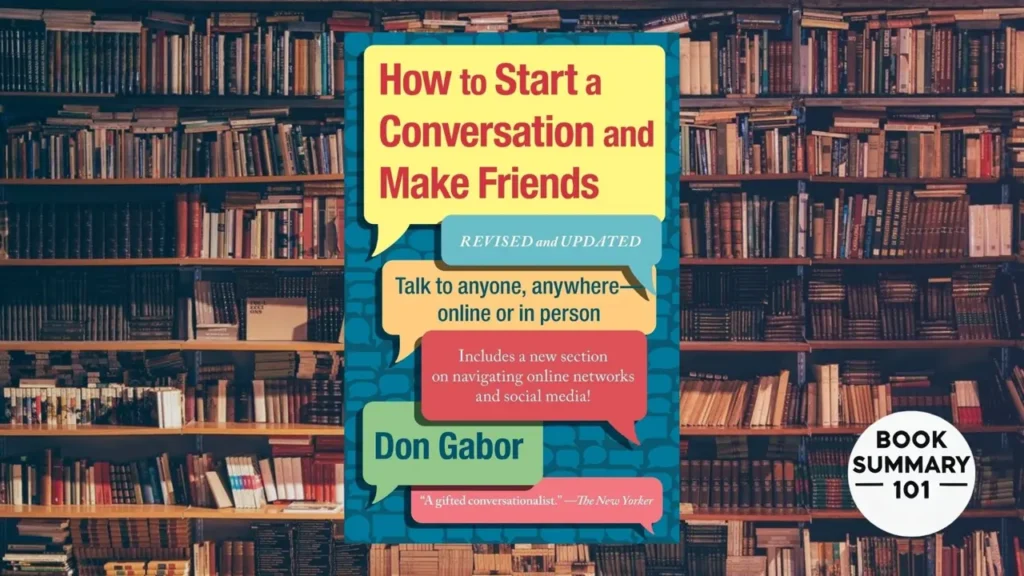If you’ve ever felt awkward starting a conversation with someone new, or wondered why making new friends seems so easy for others, How to Start a Conversation and Make Friends by Don Gabor might just be the guide you’ve been looking for. Gabor dives into practical strategies that can help you connect with others, whether you’re in a room full of strangers or just trying to get past small talk. Let’s explore how this book breaks down conversation into a skill that anyone can master.
Why Read This Book?
First, let’s talk about why this book is worth your time. How to Start a Conversation and Make Friends isn’t just a list of rules about talking to people—it’s about connecting on a deeper level and building genuine relationships. Gabor explains that good conversation skills can boost your confidence and make you more comfortable in all kinds of social settings, from networking events to family gatherings. For anyone who wants to make friends more easily, this book offers straightforward techniques that actually work. And the best part? These tips are simple to put into practice right away.
From Small Talk to Real Talk—Here’s How It Actually Works
Don Gabor’s book shines in its practical advice, and the real-life examples he shares help make the tips relatable and easy to visualize. Here, I’ll dive into each example from the book, adding extra context to bring them to life. Imagine yourself in these situations and how these techniques could change your social experience from feeling awkward or forced to comfortable and engaging.
Breaking the Ice with a Friendly Greeting
Starting a conversation is often the hardest part, but Gabor breaks it down into simple, friendly gestures. A greeting is the easiest way to signal you’re open to interaction. Picture this: You’re at a company event, standing around with your drink, not sure who to approach or what to say. Instead of waiting for someone else to start talking to you, take a deep breath, look around for someone who seems approachable, and try a light greeting.
Gabor suggests something simple, like “Hi, I’m [Your Name]. How did you get involved with this company?” or “Hi, I don’t think we’ve met yet. How’s your evening going?” That opener not only introduces you but gives the other person an easy way to respond.
Example in Action: You’re at a neighborhood gathering and feel out of place because you don’t know anyone well. Instead of standing by the snack table, try walking over to a small group and introducing yourself with a warm smile. You might say, “Hi, I’m new to the area. Have you lived here long?” Most people are happy to chat about something personal but light, like their experience in the neighborhood, and before you know it, the conversation can flow from there.
Using Open-Ended Questions
One of Gabor’s strongest suggestions is the power of open-ended questions to keep the conversation moving. Open-ended questions invite the other person to elaborate, providing more material for you to work with. They also prevent the dreaded “yes” or “no” responses that can leave conversations stalling.
Let’s imagine you’re at a friend’s party and meet someone who seems interesting. Instead of asking, “Are you having a good time?” (which could be answered with a short “yes”), try something like, “What’s been the highlight of the night for you so far?” This question prompts them to share a specific experience, and you’ll likely get a response that tells you more about their personality.
Example in Action: You’re in a class or training session, and the person next to you seems friendly. Instead of starting with “Do you like the class?” try asking, “What drew you to this class in the first place?” This question is more open and lets the other person share their motivations, providing insight into their interests and background. From there, you might find shared interests or even get tips on class resources, leading to a richer conversation.
Finding Common Ground
People feel most comfortable when they discover something they have in common, whether it’s a favorite book, a shared hobby, or a similar life experience. Gabor suggests actively looking for commonalities as you chat, even if it means stepping outside your comfort zone a little. Let’s say you’re at a networking event and meet someone who seems interested in discussing the latest industry trends, but you’re more of a tech person. You can find common ground by exploring topics that touch on both areas.
For example, you could ask, “What do you think about the latest tech developments in our industry?” This question ties in your own interest with theirs, opening up space for a natural, engaging discussion.
Example in Action: Imagine you’re at a community meetup and notice someone carrying a book that you’ve read or heard about. You might say, “I see you’re reading [Book Title]—I loved that one! What do you think of it so far?” Or, if you’re less familiar with the book, try, “I’ve heard a lot about that book. What’s it about?” This shows interest and creates a chance for them to share something they’re enthusiastic about, which could lead to discovering other shared interests in literature or related topics.
Listening More Than You Speak
A golden rule in Gabor’s approach is to listen actively. This means giving people your full attention, showing genuine interest, and using body language to show you’re engaged. Good listeners make others feel valued, creating a welcoming space where people feel comfortable opening up. It’s tempting to fill the silence with our own stories, but holding back and listening can often lead to more meaningful conversations.
Picture yourself at a networking event where everyone seems focused on pitching themselves. Instead of jumping in with your own pitch, you decide to ask open-ended questions and let others do the talking. When they share something, follow up with clarifying questions that show you’re paying attention, like, “That sounds challenging! How did you manage it?” or “Wow, that’s impressive—how did you get into that field?”
Example in Action: You’re catching up with a friend you haven’t seen in a while, and they start talking about a difficult experience at work. Rather than jumping in with advice or a similar story of your own, you stay focused on their words, nodding, asking questions, and letting them vent. A simple “That sounds tough; tell me more” can make a huge difference. They feel heard, and the conversation becomes a safe space where they’re comfortable sharing more.
Bringing It All Together: These Tips in Everyday Situations
From casual social events to formal networking meetings, Don Gabor’s book is packed with advice on using these real-life tactics to start meaningful conversations. Whether you’re chatting with a stranger, reconnecting with a friend, or meeting a new colleague, these skills can be easily adapted to make you feel more confident and genuine.
Each of these examples can become part of your daily routine—asking open-ended questions, greeting others warmly, finding shared interests, and truly listening—helping you turn small talk into conversations that matter.
Key Takeaways for Anyone Wanting to Make Friends
Gabor breaks down some easy-to-remember steps for becoming more approachable and confident in social situations. Here are a few more pointers:
- Express Genuine Interest: People can tell when you’re just making small talk versus when you’re truly interested in what they have to say. Show enthusiasm and find a topic that sparks curiosity.
- Be Positive and Upbeat: Positive energy is contagious. Approach conversations with a positive outlook, and others will be more inclined to engage with you.
- Handle Awkward Silences with Ease: Silence can be uncomfortable, but Gabor suggests letting it pass naturally or using it as an opportunity to pivot to a new topic or question.
Join the Conversation!
How to Start a Conversation and Make Friends is a fantastic guide for anyone wanting to improve their social skills and feel more at ease in any setting. Gabor’s tips, from breaking the ice with a smile to asking open-ended questions, are not just theory—they’re backed by real examples that make them easy to apply in your own life.
So, whether you’re at a party, in a professional meeting, or just hoping to make new connections at your local coffee shop, try out a few of these tips and watch your confidence grow. With a bit of practice, you’ll find that starting conversations and making friends can be enjoyable—even for the most introverted among us.
5 standout quotes from How to Start a Conversation and Make Friends by Don Gabor
1. “Conversation is a social skill that can be learned, practiced, and mastered—just like any other skill.”
This reminds us that being good at talking to people isn’t about being born with charisma—it’s something anyone can develop.
2. “The most important thing in communication is to show a genuine interest in others.”
Authentic curiosity goes a long way in building connections—people can feel it when you’re truly engaged.
3. “People will forget what you said, but they won’t forget how you made them feel.”
You don’t need perfect words—what matters most is creating a warm, safe space for conversation.
4. “Asking the right question is often more important than having the right answer.”
This is a game-changer for shy folks: you don’t have to talk a lot—just ask thoughtfully and listen well.
5. “Every conversation is an opportunity to learn something new and make a friend.”
Think of every social interaction as a door—you never know what connection or lesson could be waiting behind it.


